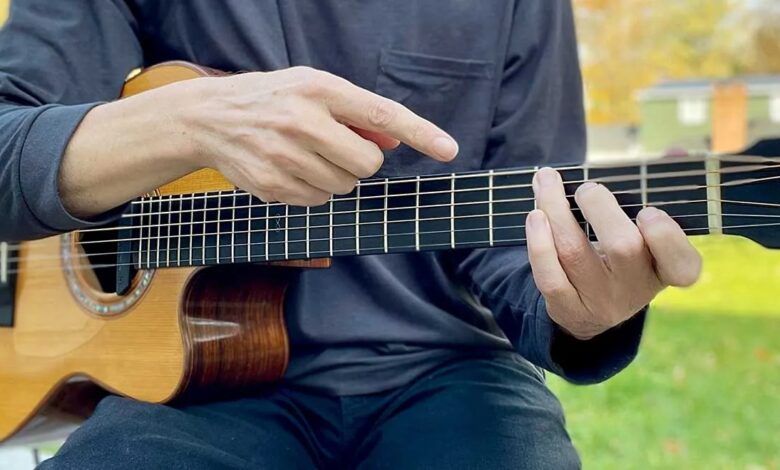Guitar Basics: How to Connect Chords with Bass Runs

So far in this series of lessons on chord embellishment basics, we’ve talked about adding or changing notes in the open chord shapes—using hammer-ons and pull-offs, sus and add chord voicings, and bluesy colors. Now let’s turn our attention to the bottom of the chords: the all-important bass notes. Playing single bass notes is a great way to thin out your accompaniment, so you’re not continually strumming, and you can go a step further and create simple bass runs that carry you from one chord to the next. That’s the focus of this lesson.
We’ll start off with a series of examples that use a bass run to connect two chords, and then we’ll try out bass runs in a few classic progressions.
Up and Down the Scale
The foundation of the examples in this lesson is the bass/strum style—a bass note followed by a chord strum. That’s known variously in guitar-speak as the boom-chuck, boom-chick, or (as Gillian Welch refers to it in this issue) boom-chang. Whatever you want to call it, you can see the basic move in the first half of each measure in Example 1. On the G chord in measure 1, for instance, play a G bass note (the root of the chord) on the sixth string on beat 1, and then strum the upper strings on beat 2.
Then, after that G bass/strum, play a short bass run that leads to the next chord, C; play A and B notes on the fifth string on the way to the C bass note in measure 2. You are simply walking up the major scale to reach the next chord. Once you arrive on the C chord, resume the bass/strum, this time with an alternating bass: play a C bass note on beat 1, and a G on beat 3. For the G bass note, keep holding the C shape and just shift your ring finger over to the sixth string.
Continue this pattern for the rest of Ex. 1. Work through the example two bars at a time, going from G to C, C to F, A to D, and E to A. In each pair, walk up to the second chord. If you think of the first chord of the pair as the I chord, you are walking up to the IV—a very common move.
On the F chord, shift your ring finger over to the fifth string for the alternate bass note, as you did on the C chord. Going from A to D and from E to A, you’ll need to move quickly away from the first chord shape after the strum in order to fret the bass run.
In Example 2, try the same basic pattern starting on minor chords. In the first two measures, play a bass/strum on Am and then a bass run leading to C. Then do the same with Em to G, and Em to Am. As with the earlier examples, the bass run is climbing the corresponding scale.
You can also reverse any of these bass runs and descend from one chord to another. Example 3 shows how that might go with a few chord pairs from Exs. 1 and 2. Play bass runs that descend from C to G, C to Am, and G to Em.
When you’re going between G and D chords, the bass run looks a bit different because the root bass notes of these chords are not on adjacent strings, as they were with all the chord pairs we looked at previously. Example 4 shows how you might play a bass run from a G chord to a D, and then from a D chord to a G. Going from D to G, you could walk up the fourth string and land on the open third string for G, but that third-string G note is pretty high and doesn’t really register as a bass note. So instead, drop down an octave to the open sixth string, as shown, and walk up to the G.
Chromatic Runs
You also can play bass runs that move chromatically—that is, in half steps, or one fret at a time—rather than sticking to scale notes. In the first two bars of Example 5, go from a G to an Am with a bass run that ascends from G to G# to A. Do the same in the next two bars from C to Dm, with the bass run C to C# to D.
Bass runs don’t always have to start on the root of the chord. In Example 6, play a bass/strum on E major and then a bass run that climbs the fifth string, approaching the root of the B7 chord chromatically—A, A#, B. In Example 7, the bass run goes the opposite direction. Play an Em and then a bass run that descends the fifth string: B, A#, A. In both of these examples, the key is timing the bass run so that you land on the root of the next chord right on the downbeat.
One song that uses a short chromatic bass run like this is the Grateful Dead’s “Ripple.” The song is in the key of G, and the chorus (“Ripple in still water…”) kicks off with an Am. You can make the transition between G and Am with a bass run like the one in Example 8. Play one measure of a bass/strum on G (with a little hammer-on for decoration), and then in measure 2, walk the bass down from B to A# to A, leading to the Am chord.
Making Connections
Bass runs really come to life when you use them in longer chord progressions. Here are a couple of examples inspired by classic songs.
Example 9 is based on the verse progression from Neil Young’s “Comes a Time,” which has an easygoing country/folk feel in the key of G. Use bass runs throughout this eight-bar progression to move from chord to chord. Going from G to Bm in measure 2, play a chromatic bass run up the fifth string. In measure 4, walk the bass from B up to D. In measures 6 and 7, walk the bass down to Am and then back up to C. Throughout, the bass runs add momentum to the progression.
Finally, for Example 10, run through the progression from the ever-popular traditional song “House of the Rising Sun.” The song is in 6/8 time—count the beats in two sets of three. The chords change almost every measure, so there are lots of opportunities to practice connecting bass runs. Here the bass runs mostly fall on the last two eighth notes of the measure, leading to the root bass note of the new chord on the downbeat.
In measures 9 and 10, fret the low G bass note with your pinkie while continuing to hold down the chord shape (Am and then E7). On the E chords in measures 7–8 and 12, toggle between E and E7—this is the kind of bluesy embellishment discussed in the previous lesson.
Of course bass runs can be overdone—you wouldn’t want to use one for every chord change necessarily. It’s important to leave space and not compete with vocals or other things going on with the music. But bass runs, used tastefully, are a great tool for giving a little nudge to your chord progression and groove.





